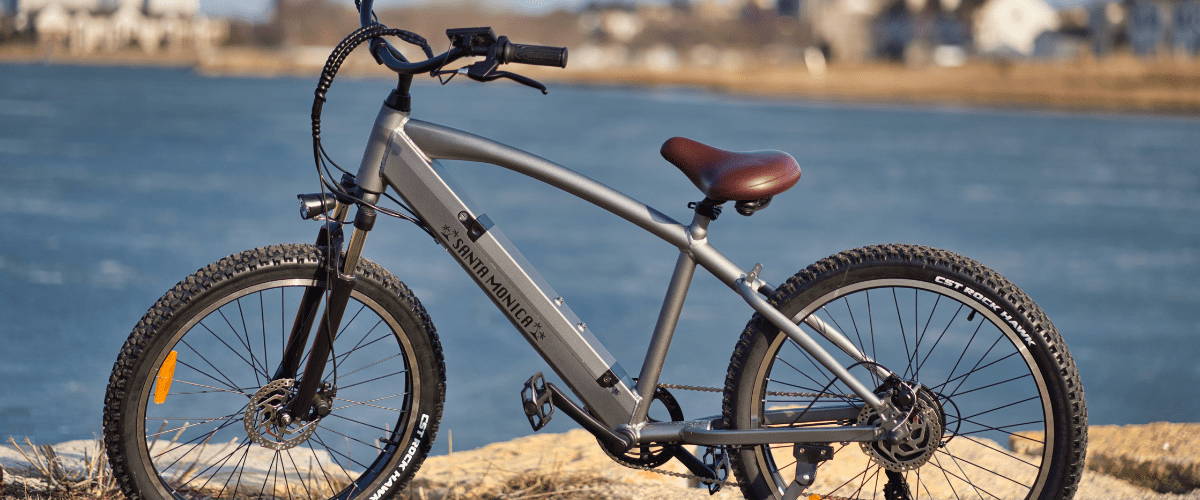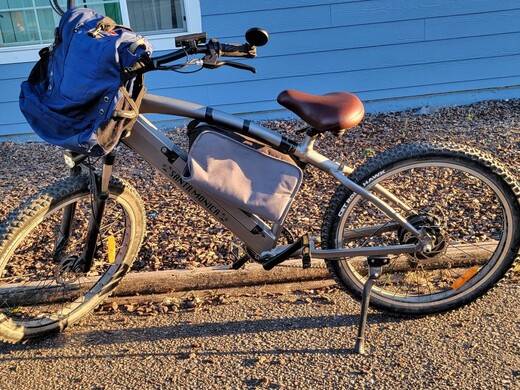
Understanding Electric Bike Component Durability: What You Need To Know
Unlike traditional bicycles, e-bikes use electric motors and batteries to enable riders to cycle longer distances, tackle challenging terrain, and reduce physical strain.
The durability and functionality of key e-bike components are critical to potential buyers and enthusiasts alike, and they include:
- Bicycle motor durability, the
- e-bike battery life.
- brakes and braking components.
- Tyres and wheels.
- Suspension systems
Let's explore the benefits of e-bikes and what you need to know about e-bike component durability.

The Benefits of E-Bikes
E-bikes, as a revolutionary mode of transport, offer a new way of travelling by combining the health and environmental benefits of traditional bicycles with the convenience of modern technology. Equipped with electric motors and rechargeable batteries, they enable riders to receive power assistance when needed, thereby reducing physical exertion and increasing the enjoyment and efficiency of cycling. This unique combination not only makes e-bikes ideal for urban commuting, but also opens up more possibilities for exploration and leisure activities.
Electric bikes offer many advantages, including:
Time-Saving
E-bikes can help you avoid traffic jams, find parking spots easily, and travel faster than regular bikes. You can also use them on bike lanes or paths, which are often more convenient and safer than roads.
Cost Saving
E-bikes are cheaper to buy and maintain than cars or motorcycles. You don't need to pay for gas, insurance, or registration fees. You only need to charge your battery, which costs much less than fueling your tank.
Energy Saving
E-bikes can reduce your physical exertion and make your ride more comfortable and enjoyable. You can adjust the level of assistance from the motor according to your preference and terrain.
The bike also allows you to switch to manual mode if you want to exercise more or save battery power.
Reduced Environmental Impact
E-bikes are eco-friendly and produce zero emissions. They can help you lower your carbon footprint and contribute to a cleaner and greener planet.
E-bikes also use fewer resources and materials than cars or motorcycles, which reduces waste and pollution.
Improved Health and Fitness
Riding an e-bike can improve your cardiovascular health, strengthen your muscles, and help you burn calories. Regular cycling can also reduce stress, boost your mood, and enhance your mental well-being.
Fortunately, e-bikes are suitable for people of all ages and fitness levels. They can accommodate different needs and abilities.

Key Components and Durability of Electric Bicycles
The e-bike consists of several key components, like a motor, battery, brakes, tires, and suspension system. Let's take a look at these components and their durability.
E-bike Motor Durability
The e-bike motor is one of the most important components of this device. It provides the power and speed that differentiate e-bikes from regular bikes.
The durability of an e-bike motor depends on several factors, such as the type, capacity, quality, and usage of the motor. Generally, an e-bike motor can last up to 10 years without any repairs. However, this longevity can vary depending on the motor type, capacity, manufacturer, and how you use it.
For example, a mid-drive motor may last longer than a hub motor, as it is more efficient and less prone to overheating. Also, if the motor has a higher wattage, it will last longer than a lower-wattage motor since it does not need to work as hard to reach the same speed.
The quality and maintenance of the motor can also affect its lifespan. A well-made and well-maintained motor can last longer than a poorly-maintained one. Therefore, it is important to choose a reliable and reputable e-bike motor brand. It is also best to follow the manufacturer's instructions on how to care for and clean the motor.
You can also extend the life of your e-bike motor by not overloading or overspeeding the motor. You should also keep it dry and lubricate moving parts regularly.
E-bike Battery Lifespan
The battery is another crucial component of an e-bike. This component stores the energy that powers the motor. The lifespan of an e-bike battery varies. However, generally, it can last between 2 to 5 years or 10,000 to 30,000 miles. Also, the battery type, manufacturer, quality, and usage also affect its lifespan.
For instance, let's consider two battery types - lithium-ion (Li-ion) and lead-acid (PbA). Li-ion batteries last longer than PbA batteries because they are lightweight and more efficient.
Also, the quality and maintenance of the battery can affect its lifespan. Maintaining your battery frequently can help you get more juice out of it. You can check out the manufacturer's instructions on your e-bike battery to learn how to care for and charge the battery.
Some tips for extending your e-bike battery life include avoiding letting the battery drain completely or overcharge and keeping the battery in a cool and dry place.
In addition, if you are storing the battery, do so at around 50% charge and check for any signs of damage or wear.
Brake and Brake Components
Brakes are essential for controlling the speed and stopping the motion of your e-bike. There are two main types of brakes for e-bikes: rim brakes and disc brakes. Rim brakes use pads that squeeze against the rim of the wheel, while disc brakes use calipers that clamp onto a rotor attached to the hub of the wheel. Generally, disc brakes are more common and preferred for e-bikes because they offer more power, reliability, and durability than rim brakes.
The main components of a disc brake system are the brake lever, the brake cable, the brake caliper, the brake pads, and the rotor. The brake lever is what you use to apply pressure to the brakes, activating the system. The brake cable transfers the force from the brake lever to the brake caliper, while the brake caliper is the device that holds the brake pads and squeezes them against the rotor. The brake pads then create friction to slow down the wheel. The rotor is the metal disc that rotates with the wheel and provides the surface for the brake pads to grip.
The e-bike's brake system can be either mechanical or hydraulic, depending on how the brake cable is filled. Mechanical brakes use a steel cable, while hydraulic brakes use a fluid-filled hose. Hydraulic brakes are more efficient, responsive, and self-adjusting than mechanical brakes, but they are also more expensive and complex to maintain.
To ensure the safety and performance of your e-bike brakes, you should regularly inspect, clean, and replace the components as needed. Some signs that your brakes need attention are squeaking, grinding, rubbing, or fading noises. If you also notice reduced braking power, longer stopping distance, or uneven wear on the pads or rotor, you should inspect your brakes.
Tires and Wheels
Tires and wheels are the parts of your e-bike that make contact with the ground and affect your traction, comfort, and speed. The size, width, tread, and pressure of your tires and wheels can have a significant impact on your e-bike performance and durability.
Generally, electric bicycle tires can last between 1 to 3 years, or for about 1000 to 3000 miles of riding.
It is important to note that larger and wider tires and wheels offer more stability, cushioning, and grip. On the other hand, smaller and narrower tires and wheels offer more agility, efficiency, and speed.
The tread pattern of your tires can also influence how well they handle different terrains and conditions. For example, knobby tires are better for off-road and muddy surfaces, while slick tires are better for smooth and dry surfaces.
The pressure of your tires can also affect your ride quality and safety. Too much pressure can make your ride harsh and bumpy, while too little pressure can make your ride sluggish and puncture-prone.
It is important to choose the right tires and wheels for your e-bike and to follow the manufacturer's recommendations on how to inflate and maintain them.
Suspension Systems
Suspension systems are designed to absorb shock and vibration from the road to provide a smoother and more comfortable ride for the rider. e-bikes have three main types of suspension systems - front, rear, and full suspension.
Front suspension systems feature a suspension fork installed in the front wheel of the e-bike. It plays a crucial role in absorbing shocks from the front, especially when riding over obstacles, potholes, or rough terrain.
Rear suspension systems feature a rear shock absorber that is attached to the frame and the rear wheel of the e-bike. It helps to cushion the impact from the rear, especially when descending hills or jumping over bumps.
Full suspension systems feature both a suspension fork and a rear shock absorber, providing the best of both worlds. They offer the most stability, comfort, and control, especially on uneven and challenging terrain. However, they are also the most expensive and complex to maintain.
The durability of e-bike suspension systems depends on several factors, such as the type, quality, usage, and maintenance of the suspensions. Generally, e-bike suspension systems can last up to 10,000 miles or more. In addition, the quality and maintenance of the suspensions can affect their lifespan.

Conclusion
Electric bikes offer several benefits, including saving time, money, and energy. It also reduces environmental impact and improves health and fitness. This article has explored the main components of e-bikes, such as the motor, battery, brakes, tires, wheels, and suspension systems, and their durability.
One of the key ways of getting the most out of your e-bike components is to purchase quality products from reputable suppliers. You can reach out to us for your e-bike and its accessories. We offer only quality products.


